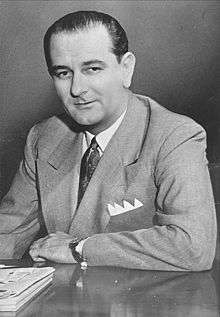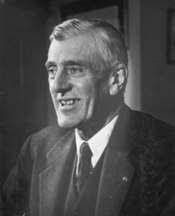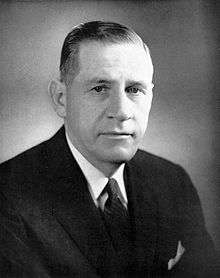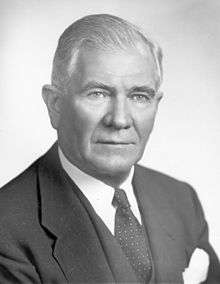United States Senate elections, 1954
|
| |||||||||||||||||||||||||||||||||||||||||||||||||||||||||||||||||
| |||||||||||||||||||||||||||||||||||||||||||||||||||||||||||||||||
38 of the 96 seats in the United States Senate 49 seats needed for a majority | |||||||||||||||||||||||||||||||||||||||||||||||||||||||||||||||||
|---|---|---|---|---|---|---|---|---|---|---|---|---|---|---|---|---|---|---|---|---|---|---|---|---|---|---|---|---|---|---|---|---|---|---|---|---|---|---|---|---|---|---|---|---|---|---|---|---|---|---|---|---|---|---|---|---|---|---|---|---|---|---|---|---|---|
| |||||||||||||||||||||||||||||||||||||||||||||||||||||||||||||||||
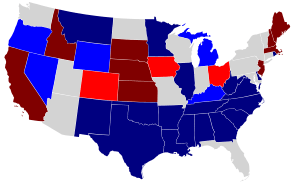 Results including special elections Democratic gain Republican gain Democratic hold Republican hold | |||||||||||||||||||||||||||||||||||||||||||||||||||||||||||||||||
| |||||||||||||||||||||||||||||||||||||||||||||||||||||||||||||||||
The United States Senate elections of 1954 was a midterm election in the first term of Dwight D. Eisenhower's presidency. Eisenhower's Republican party lost a net of two seats to the Democratic opposition. This small change was just enough to give Democrats control of the chamber with the support of an Independent (Wayne Morse of Oregon) who caucused with them.
The elections resulted in a divided government that continued to the end of Eisenhower's presidency and a Democratic majority that would last until 1981.
Incumbents defeated
Democrats defeated incumbents John S. Cooper (R-KY), Homer Ferguson (R-MI), Ernest S. Brown (R-NV), and Guy Cordon (R-OR).
Republicans took the seats of incumbents Guy M. Gillette (D-IA) and Thomas A. Burke (D-OH).
Open seat gains
Democrats took an open seat in Wyoming.
Republicans took an open seat in Colorado.
Change in Senate composition
Before the elections
Going into the November elections.
| D1 | D2 | D3 | D4 | D5 | D6 | D7 | D8 | ||
| D18 | D17 | D16 | D15 | D14 | D13 | D12 | D11 | D10 | D9 |
| D19 | D20 | D21 | D22 | D23 | D24 | D25 | D26 | D27 Ran |
D28 Ran |
| D38 Ran |
D37 Ran |
D36 Ran |
D35 Ran |
D34 Ran |
D33 Ran |
D32 Ran |
D31 Ran |
D30 Ran |
D29 Ran |
| D39 Ran |
D40 Ran |
D41 Ran |
D42 Ran |
D43 Ran |
D44 Ran |
D45 Retired |
D46 Retired |
I1 | R49 Retired |
| Majority → | |||||||||
| R39 Ran |
R40 Ran |
R41 Ran |
R42 Ran |
R43 Ran |
R44 Ran |
R45 Ran |
R46 Ran |
R47 Retired |
R48 Retired |
| R38 Ran |
R37 | R36 | R35 | R34 | R33 | R32 | R31 | R30 | R29 |
| R19 | R20 | R21 | R22 | R23 | R24 | R25 | R26 | R27 | R28 |
| R18 | R17 | R16 | R15 | R14 | R13 | R12 | R11 | R10 | R9 |
| R1 | R2 | R3 | R4 | R5 | R6 | R7 | R8 | ||
Results of the general elections
| D1 | D2 | D3 | D4 | D5 | D6 | D7 | D8 | ||
| D18 | D17 | D16 | D15 | D14 | D13 | D12 | D11 | D10 | D9 |
| D19 | D20 | D21 | D22 | D23 | D24 | D25 | D26 | D27 Re-elected |
D28 Re-elected |
| D38 Re-elected |
D37 Hold |
D36 Re-elected |
D35 Re-elected |
D34 Re-elected |
D33 Re-elected |
D32 Re-elected |
D31 Re-elected |
D30 Re-elected |
D29 Re-elected |
| D39 Re-elected |
D40 Re-elected |
D41 Re-elected |
D42 Re-elected |
D43 Re-elected |
D44 Hold |
D45 Gain |
D46 Gain |
D47 Gain |
D48 Gain |
| Plurality ↑ | |||||||||
| R39 Re-elected |
R40 Re-elected |
R41 Re-elected |
R42 Re-elected |
R43 Re-elected |
R44 Hold |
R45 Hold |
R46 Gain |
R47 Gain |
I1 |
| R38 Re-elected |
R37 | R36 | R35 | R34 | R33 | R32 | R31 | R30 | R29 |
| R19 | R20 | R21 | R22 | R23 | R24 | R25 | R26 | R27 | R28 |
| R18 | R17 | R16 | R15 | R14 | R13 | R12 | R11 | R10 | R9 |
| R1 | R2 | R3 | R4 | R5 | R6 | R7 | R8 | ||
Results of the special elections
| D1 | D2 | D3 | D4 | D5 | D6 | D7 | D8 | ||
| D18 | D17 | D16 | D15 | D14 | D13 | D12 | D11 | D10 | D9 |
| D19 | D20 | D21 | D22 | D23 | D24 | D25 | D26 | D27 | D28 |
| D38 | D37 | D36 | D35 | D34 | D33 | D32 | D31 | D30 | D29 |
| D39 | D40 | D41 | D42 | D43 | D44 | D45 Appointee elected |
D46 Hold, same as general |
D47 Gain, same as general |
D48 Gain |
| Plurality ↑ | |||||||||
| R39 | R40 | R41 | R42 | R43 Appointee elected |
R44 Hold, same as general |
R45 Hold |
R46 Hold |
R47 Gain |
I1 |
| R38 | R37 | R36 | R35 | R34 | R33 | R32 | R31 | R30 | R29 |
| R20 | R22 | R23 | R24 | R44 | R45 | R25 | R26 | R27 | R28 |
| R18 | R17 | R16 | R15 | R14 | R13 | R12 | R11 | R10 | R9 |
| R1 | R2 | R3 | R4 | R5 | R6 | R7 | R8 | ||
| Key: |
|
Race summaries
Special elections during the 83rd Congress
In these special elections, the winners were seated during 1954 or before January 3, 1955; ordered by election date, then state, then class.
| State | Incumbent | Results | Candidates | ||
|---|---|---|---|---|---|
| Senator | Party | Electoral history | |||
| California (Class 3) |
Thomas Kuchel | Republican | 1953 (Appointed) | Interim appointee elected November 2, 1954. | √ Thomas Kuchel (Republican) 53.2% Samuel W. Yorty (Democratic) 45.5% Isobel M. Cerney (Independent-Progressive) 1.2% |
| Nebraska (Class 1) |
Samuel W. Reynolds | Republican | 1954 (Appointed) | Interim appointee retired. New senator elected November 2, 1954. Republican hold. |
√ Roman L. Hruska (Republican) 60.9% James F. Green (Democratic) 39.1% |
| Nebraska (Class 2) |
Eva Bowring | Republican | 1954 (Appointed) | Interim appointee retired. New senator elected November 2, 1954. Republican hold. Winner was not elected to the next term, see below. |
√ Hazel H. Abel (Republican) 57.8% William H. Meier (Democratic) 42.2% |
| Nevada (Class 3) |
Ernest S. Brown | Republican | 1954 (Appointed) | Interim appointee lost election. New senator elected November 2, 1954. Democratic gain. |
√ Alan Bible (Democratic) 58.1% Ernest S. Brown (Republican) 41.9% |
| New Hampshire (Class 3) |
Robert W. Upton | Republican | 1953 (Appointed) | Interim appointee lost nomination. New senator elected November 2, 1954. Republican hold. |
√ Norris Cotton (Republican) 60.2% Stanley J. Betley (Democratic) 39.8% |
| North Carolina (Class 2) |
Alton Asa Lennon | Democratic | 1953 (Appointed) | Interim appointee lost nomination. New senator elected November 2, 1954. Democratic hold. Winner also elected to next term, see below. |
√ William Kerr Scott (Democratic) 65.9% Paul C. West (Republican) 34.1% |
| North Carolina (Class 3) |
Sam Ervin | Democratic | 1954 (Appointed) | Interim appointee elected November 2, 1954. | √ Sam Ervin (Democratic) Unopposed |
| Ohio (Class 3) |
Thomas A. Burke | Democratic | 1953 (Appointed) | Interim appointee lost election. New senator elected November 2, 1954. Republican gain. |
√ George H. Bender (Republican) 50.1% Thomas A. Burke (Democratic) 49.9% |
| Wyoming (Class 2) |
Edward D. Crippa | Republican | 1954 (Appointed) | Interim appointee retired. New senator elected November 2, 1954. Democratic gain. Winner also elected to the next term, see below. |
√ Joseph C. O'Mahoney (Democratic) 51.6% William H. Harrison (Republican) 48.4%[2] |
Races leading to the 83rd Congress
In these general elections, the winner was seated on January 3, 1953; ordered by state.
All of the elections involved the Class 2 seats.
| State | Incumbent | Results | Candidates | ||
|---|---|---|---|---|---|
| Senator | Party | Electoral history | |||
| Alabama | John Sparkman | Democratic | 1946 (Special) 1948 |
Incumbent re-elected. | √ John Sparkman (Democratic) 82.5% Junius Foy Guin, Jr. (Republican) 17.5% |
| Arkansas | John L. McClellan | Democratic | 1942 1948 |
Incumbent re-elected. | √ John L. McClellan (Democratic) Unopposed |
| Colorado | Edwin C. Johnson | Democratic | 1936 1942 1948 |
Incumbent retired. New senator elected. Republican gain. |
√ Gordon Allott (Republican) 51.3% John A. Carroll (Democratic) 48.7% |
| Delaware | J. Allen Frear, Jr. | Democratic | 1948 | Incumbent re-elected. | √ J. Allen Frear, Jr. (Democratic) 56.9% Herbert B. Warburton (Republican) 43.1% |
| Georgia | Richard Russell, Jr. | Democratic | 1933 (Special) 1936 1942 1948 |
Incumbent re-elected. | √ Richard Russell, Jr. (Democratic) Unopposed |
| Idaho | Henry C. Dworshak | Republican | 1946 (Special) 1948 (Lost) 1949 (Appointed) 1950 (Special) |
Incumbent re-elected. | √ Henry C. Dworshak (Republican) 62.8% Glen H. Taylor (Democratic) 37.2% |
| Illinois | Paul Douglas | Democratic | 1948 | Incumbent re-elected. | √ Paul Douglas (Democratic) 53.6% Joseph T. Meek (Republican) 46.4% |
| Iowa | Guy M. Gillette | Democratic | 1936 (Special) 1938 1944 (Lost) 1948 |
Incumbent lost re-election. New senator elected. Republican gain. |
√ Thomas E. Martin (Republican) 52.2% Guy M. Gillette (Democratic) 47.5% Ernest Seemann (Republicsons) 0.3% |
| Kansas | Andrew F. Schoeppel | Republican | 1948 | Incumbent re-elected. | √ Andrew F. Schoeppel (Republican) 56.3% George McGill (Democratic) 41.8% David C. White (Prohibition) 1.8% |
| Kentucky | John S. Cooper | Republican | 1946 (Special) 1948 (Lost) 1952 (Special) |
Incumbent lost re-election. New senator elected. Democratic gain. |
√ Alben W. Barkley (Democratic) 54.5% John S. Cooper (Republican) 45.5% |
| Louisiana | Allen J. Ellender | Democratic | 1936 1942 1948 |
Incumbent re-elected. | √ Allen J. Ellender (Democratic) Unopposed |
| Maine | Margaret C. Smith | Republican | 1948 | Incumbent re-elected. | √ Margaret C. Smith (Republican) 58.6% Paul A. Fullam (Democratic) 41.4% |
| Massachusetts | Leverett Saltonstall | Republican | 1944 (Special) 1948 |
Incumbent re-elected. | √ Leverett Saltonstall (Republican) 50.5% Foster Furcolo (Democratic) 49.0% |
| Michigan | Homer Ferguson | Republican | 1942 1948 |
Incumbent lost re-election. New senator elected. Democratic gain. |
√ Patrick V. McNamara (Democratic) 50.8% Homer Ferguson (Republican) 48.9% |
| Minnesota | Hubert Humphrey | Democratic | 1948 | Incumbent re-elected. | √ Hubert Humphrey (Democratic) 56.4% Val Bjornson (Republican) 42.1% |
| Mississippi | James O. Eastland | Democratic | 1942 1948 |
Incumbent re-elected. | √ James O. Eastland (Democratic) Unopposed |
| Montana | James E. Murray | Democratic | 1934 (Special) 1936 1942 1948 |
Incumbent re-elected. | √ James E. Murray (Democratic) 50.4% Wesley A. D'Ewart (Republican) 49.6% |
| Nebraska | Eva Bowring | Republican | 1954 (Special) | Interim appointee retired. New senator elected. Republican hold. Winner was not elected to finish the term, see above. |
√ Carl T. Curtis (Republican) 61.1% Keith Neville (Democratic) 38.9% |
| New Hampshire | Styles Bridges | Republican | 1936 1942 1948 |
Incumbent re-elected. | √ Styles Bridges (Republican) 60.2% Gerard L. Morin (Democratic) 39.8% |
| New Jersey | Robert C. Hendrickson | Republican | 1948 | Incumbent retired. New senator elected. Republican hold. |
√ Clifford P. Case (Republican) 48.7% Charles R. Howell (Democratic) 48.5% |
| New Mexico | Clinton P. Anderson | Democratic | 1948 | Incumbent re-elected. | √ Clinton P. Anderson (Democratic) 57.3% Edwin L. Mechem (Republican) 42.7% |
| North Carolina | Alton Asa Lennon | Democratic | 1953 (Appointed) | Interim appointee lost nomination. New senator elected. Democratic hold. Winner also elected to finish the term, see above. |
√ William Kerr Scott (Democratic) Paul C. West (Republican) |
| Oklahoma | Robert S. Kerr | Democratic | 1948 | Incumbent re-elected. | √ Robert S. Kerr (Democratic) 55.8% Fred M. Mock (Republican) 43.7% George V. Fried (Independent) 0.3% George H. Brasier (Independent) 0.2% |
| Oregon | Guy Cordon | Republican | 1944 (Appointed) 1944 (Special) 1948 |
Incumbent lost re-election. New senator elected. Democratic gain. |
√ Richard L. Neuberger (Democratic) 50.2% Guy Cordon (Republican) 49.8% |
| Rhode Island | Theodore F. Green | Democratic | 1936 1942 1948 |
Incumbent re-elected. | √ Theodore F. Green (Democratic) 59.3% Walter I. Sundlun (Republican) 40.7% |
| South Carolina | Charles E. Daniel | Democratic | 1954 | Interim appointee retired. New senator elected. Democratic hold. Incumbent then resigned December 23, 1954 to give successor preferential seniority. Winner appointed December 24, 1954 to finish the term. |
√ Strom Thurmond (Democratic) 63.1% Edgar A. Brown (Democratic) 36.8% |
| South Dakota | Karl E. Mundt | Republican | 1948 1948 (Appointed) |
Incumbent re-elected. | √ Karl E. Mundt (Republican) 57.3% Kenneth Holum (Democratic) 42.7% |
| Tennessee | Estes Kefauver | Democratic | 1948 | Incumbent re-elected. | √ Estes Kefauver (Democratic) 70.0% Tom Wall (Republican) 30.0% |
| Texas | Lyndon B. Johnson | Democratic | 1948 | Incumbent re-elected. | √ Lyndon B. Johnson (Democratic) 84.6% Carlos G. Watson (Republican) 14.9% Fred Spangler (Constitution Party) 0.5% |
| Virginia | A. Willis Robertson | Democratic | 1946 (Special) 1948 |
Incumbent re-elected. | √ A. Willis Robertson (Democratic) 79.9% Charles W. Lewis, Jr. (Independent-Democrat) 10.7% Clarke T. Robb (Virginia Social Democrat) 9.4% |
| West Virginia | Matthew M. Neely | Democratic | 1922 1928 (Lost) 1930 1936 1941 (Resigned) 1948 |
Incumbent re-elected. | √ Matthew M. Neely (Democratic) 54.8% Thomas Sweeney (Republican) 45.2% |
| Wyoming | Edward D. Crippa | Republican | 1954 (Appointed) | Interim appointee retired. New senator elected. Democratic gain. Winner also elected to finish the term, see above. |
√ Joseph C. O'Mahoney (Democratic) 51.5% William H. Harrison (Republican) 48.5%[2] |
Massachusetts
|
| |||||||||||||||||
| |||||||||||||||||
| |||||||||||||||||
In Massachusetts, Republican Incumbent Leverett Saltonstall defeated his challengers.
Democrat Foster Furcolo (Treasurer and Receiver-General of Massachusetts since 1952 and member of the United States House of Representatives from Massachusetts's 2nd congressional district from 1949-1952) beat John I. Fitzgerald (former member of the Boston City Council and Democratic candidate for Senate in 1948) and Joseph L. Murphy (former member of the Massachusetts Senate).
Republican incumbent Leverett Saltonstall (United States Senator since 1945 and Governor of Massachusetts from 1939-1945) was renominated. Other nominees included Socialist Workers Thelma Ingersoll (ran for Senate in 1952.[3]) and Prohibition Harold J. Ireland (candidate for Treasurer and Receiver-General in 1948 and 1952).
| Party | Candidate | Votes | % | |
|---|---|---|---|---|
| Democratic | Foster Furcolo | 207,232 | 59.13% | |
| Democratic | Joseph L. Murphy | 79,463 | 22.68% | |
| Democratic | John I. Fitzgerald | 63,752 | 18.19% | |
| Party | Candidate | Votes | % | ± | |
|---|---|---|---|---|---|
| Republican | Leverett Saltonstall | 956,605 | 50.54% | -2.41% | |
| Democratic | Foster Furcolo | 927,899 | 49.03% | +2.60% | |
| Socialist Labor | Thelma Ingersoll | 5,353 | 0.28% | -0.17% | |
| Prohibition | Harold J. Ireland | 2,832 | 0.15% | -0.03% | |
Montana
In Montana incumbent senator James E. Murray, who was first elected to the Senate in a special election in 1934 and was re-elected in 1936, 1942, and 1948, ran for re-election.
Murray won the Democratic primary against trivial opponents (farmer Ray E. Gulick and Sam G. Feezell).
| Party | Candidate | Votes | % | |
|---|---|---|---|---|
| Democratic | James E. Murray (inc.) | 65,896 | 86.94% | |
| Democratic | Ray E. Gulick | 4,961 | 6.55% | |
| Democratic | Sam G. Feezell | 4,941 | 6.52% | |
| Total votes | 75,798 | 100.00% | ||
Republican Wesley A. D'Ewart United States Congressman from Montana's 2nd congressional district beat Robert Yellowtail, former Superintendent of the Crow Indian Reservation, for the GOP nomination.
| Party | Candidate | Votes | % | |
|---|---|---|---|---|
| Republican | Wesley A. D'Ewart | 49,964 | 82.36% | |
| Republican | Robert Yellowtail | 10,705 | 17.64% | |
| Total votes | 60,669 | 100.00% | ||
A contentious and close election ensued, but ultimately, Murray was able to narrowly win re-election over D'Ewart to a final term in the Senate.
| Party | Candidate | Votes | % | ± | |
|---|---|---|---|---|---|
| Democratic | James E. Murray (inc.) | 114,591 | 50.38% | -6.27% | |
| Republican | Wesley A. D'Ewart | 112,863 | 49.62% | +6.88% | |
| Majority | 1,728 | 0.76% | -13.15% | ||
| Turnout | 227,454 | ||||
| Democratic hold | Swing | ||||
Nebraska
Nebraska had three Senate elections on the ballot. Both Senators had died in the span of three months, leading to appointments and special elections.
- Dwight P. Griswold (R) died April 12, 1954, and Eva Bowring (R) was appointed April 16 to continue the term. In November, Hazel Abel (R) was elected to finish the term.
- Although elected to finish the term, Abel did not run for the next term, and Carl Curtis (R) was elected in November to the next term. On December 31, 1954 Abel resigned and Curtis was appointed January 1, 1955, two days ahead of his elected term.
- Hugh A. Butler (R) died July 1, 1954 and Samuel W. Reynolds (R) was appointed July 3, 1954 to continue the term. Reynolds was did not run to finish the term, and Roman Hruska (R) won the seat in November to finish the term ending in 1959.
North Carolina
Like Nebraska, North Carolina had three Senate elections on the ballot. Both Senators had died during the 83rd Congress, leading to appointments and special elections.
- Willis Smith (D) died June 26, 1953 and Alton A. Lennon (D) was appointed July 10, 1953 to continue the term. In November, Lennon lost the nomination to W. Kerr Scott (D) to finish the term. Scott took office November 29, 1954.
- W. Kerr Scott (D) was also elected to the next term, which would begin January 3, 1955.
- Clyde R. Hoey (D) died May 12, 1954 and Sam Ervin (D) was appointed June 5, 1954 to continue the term. In November, Ervin was elected to finish the term.
South Carolina
In South Carolina, Senator Burnet R. Maybank did not face a primary challenge in the summer and was therefore renominated as the Democratic Party's nominee for the election in the fall. However, his death on September 1 left the Democratic Party without a nominee and the executive committee decided to nominate state Senator Edgar A. Brown as their candidate for the election. Many South Carolinians were outraged by the party's decision to forgo a primary election and former Governor Strom Thurmond entered the race as a write-in candidate. He easily won the election and became the first U.S. Senator to be elected by a write-in vote (William Knowland of California in 1946 was technically the first, but the ballots in that election were blank with no candidates listed, so essentially every candidate was running a write-in campaign).[7]
Sitting Senator Burnet R. Maybank entered the 1954 contest without a challenge in the Democratic primary nor in the general election. His unexpected death on September 1 caused panic and confusion within the hierarchy of the state Democratic party because the state law required that a party's nominee be certified by September 3. Hours after Maybank's funeral, the state Democratic executive committee met in secret and chose state Senator Edgar A. Brown of Barnwell County as the party's nominee for the general election. Not only was Brown a part of the "Barnwell Ring", but he was also a member of the executive committee.
The state Democratic Party's decision to choose a candidate without holding a special primary election drew widespread criticism across the state. On September 3, The Greenville News ran an editorial advocating that a primary election be called and several newspapers across the state followed suit. At least six county Democratic committees repudiated the action by the state committee and called for a primary election. Despite repeated calls for a primary, the state executive committee voted against holding a primary because they did not think that there was enough time before the general election to hold a primary election.
Immediately after the executive committee voted against holding a primary election, former Governor Strom Thurmond and lumberman Marcus Stone announced their intention to run as Democratic write-in candidates. Thurmond and his supporters stated that the executive committee had several legal alternatives as opposed to the outright appointment of state Senator Brown. In addition, Thurmond promised that if he were elected he would resign in 1956 so that the voters could choose a candidate in the regular primary for the remaining four years of the term.
Thurmond received support from Governor James F. Byrnes and from those who backed his Presidential bid as a Dixiecrat in the 1948 Presidential election. Thurmond framed the race as a "moral issue: democracy versus committee rule"[8] and his write-in campaign was repeatedly assisted by every newspaper in the state, except for those in Anderson. For instance, The News and Courier devoted its front page on November 2 to show voters a sample ballot and it also provided detailed instructions on how to cast a write-in vote. Not only that, but the newspaper also printed an editorial on the front page giving precise reasons why voters should vote for Thurmond instead of Brown.
On the other hand, Brown was supported by the Democratic party regulars and he also gained the endorsement of Senator Olin D. Johnston. Brown based his campaign entirely on the issue of party loyalty, stressing that Thurmond was a Republican ally because he had voted for President Eisenhower in 1952.
Marcus A. Stone, a lumberman in Florence and Dillon, was a candidate in previous Democratic primaries for governor and senator. He did very little campaigning for the general election.
| Party | Candidate | Votes | % | ± | |
|---|---|---|---|---|---|
| Democratic | Strom Thurmond (Write-In) | 143,444 | 63.1 | +63.1 | |
| Democratic | Edgar A. Brown | 83,525 | 36.8 | -59.6 | |
| Democratic | Marcus Stone (Write-In) | 240 | 0.1 | +0.1 | |
| No party | Write-Ins | 23 | 0.0 | 0.0 | |
| Majority | 59,919 | 26.3 | -66.5 | ||
| Turnout | 227,232 | ||||
| Democratic hold | |||||
Virginia
|
| |||||||||||||||||||||
| |||||||||||||||||||||
| |||||||||||||||||||||
In Virginia, Democratic incumbent Senator Absalom Willis Robertson defeated Independent Democrat Charles Lewis and Social Democrat Clarke Robb and was re-elected to a second term in office.
| Party | Candidate | Votes | % | ± | |
|---|---|---|---|---|---|
| Democratic | Absalom Willis Robertson (Incumbent) | 244,844 | 79.88% | +14.14% | |
| Independent Democratic | Charles W. Lewis, Jr. | 32,681 | 10.66% | +10.66% | |
| Social Democratic | Clarke T. Robb | 28,922 | 9.44% | +9.02% | |
| Write-ins | 63 | 0.02% | +0.02% | ||
| Majority | 212,163 | 69.22% | +34.18% | ||
| Turnout | 306,510 | ||||
| Democratic hold | |||||
See also
Notes
- ↑ The Maine election was on September 13, 1954, and there were 9 special elections all held on November 2, 1954.
- 1 2 http://www.ourcampaigns.com/ContainerHistory.html?ContainerID=299
- ↑ Thelma Ingersoll at ourcampaigns.com
- ↑ http://www.ourcampaigns.com/RaceDetail.html?RaceID=29251
- 1 2 "Report of the Official Canvass of the Vote Cast at the Primary Election Held in the State of Montana, July 20, 1954" (PDF). Montana Secretary of State. Retrieved July 2, 2014.
- 1 2 "Statistics of the Congressional Election of November 2, 1954" (PDF). Clerk of the United States House of Representatives. Retrieved July 2, 2014.
- ↑ Washington Post, "Murkowski appears to make history in Alaska", Debbi Wilgoren, November 3, 2010 (accessed November 3, 2010)
- ↑ Lander, Ernest: A History of South Carolina 1865-1960, page 183. University of South Carolina Press, 1970.
References
- "A New Test For S.C. Voters". The News and Courier. November 2, 1954. p. 1A.
- "Brown Faces Thurmond In Write-In Race". The News and Courier. November 2, 1954. p. 1A.
- Lander, Jr., Ernest McPherson (1970). A History of South Carolina, 1865-1960. University of South Carolina Press. pp. 182–184. ISBN 0-87249-169-2.
- "Supplemental Report of the Secretary of State to the General Assembly of South Carolina." Reports and Resolutions of South Carolina to the General Assembly of the State of South Carolina. Volume I. Columbia, SC: 1955, pp. 4–5.
- U.S. Senate Biography of Strom Thurmond
